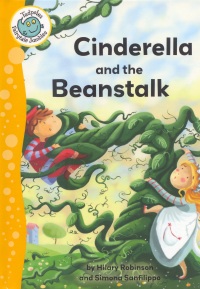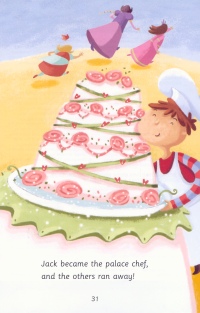| ________________
CM . . . . Volume XIX Number 35 . . . . May 10, 2013
excerpt:
Cinderella and the Beanstalk combines the plotlines of two fairytales into one story. Cinderella and Jack both live in the house of the stepmother along with the two stepsisters. Jack trades a cow for a magic bean while Cinderella mends dresses for a ball. When the bean grows into a giant beanstalk, Jack and Cinderella climb up and meet a giant fairy godmother who sends Cinderella to the ball with Jack driving the carriage. Typical events ensue until the story closes with Cinderella marrying the prince and Jack becoming the palace chef.
The illustrations are colourful and eye-catching, great for beginning readers and any lover of picture books. The images also help in clarifying the sometimes confusing text; however, the depictions of Cinderella and Jack are rather problematic. Both protagonists are portrayed at an age of about 12-years-old, but considering Cinderella gets married and Jack gets a full-time job, this raises some serious issues. Children will likely be attracted to the bright images, but using this book as a learning aid or as a read-aloud story will prove to be problematic with the fumbling text and confusing plot. Not recommended. Stephanie Johnson is a graduate of the Master of Library and Information Studies Program from the University of Alberta.
To comment
on this title or this review, send mail to cm@umanitoba.ca.
Copyright © the Manitoba Library Association. Reproduction for personal
use is permitted only if this copyright notice is maintained. Any
other reproduction is prohibited without permission.
NEXT REVIEW |
TABLE OF CONTENTS FOR THIS ISSUE
- May 10, 2013.
AUTHORS |
TITLES |
MEDIA REVIEWS |
PROFILES |
BACK ISSUES |
SEARCH |
CMARCHIVE |
HOME |

 While the idea of a jumbled fairytale is, itself, a charming one, this interpretation is inherently problematic. The text of the story is told in rhyming language, but finding the right words to rhyme seemed to be a struggle, and consequently the text becomes clunky and lacks flow. For a book that is aimed at beginning readers, the plot is quite difficult to follow as not only do the readers require preexisting knowledge of the two fairytales, but the actions of the protagonists are unclear. For example, why do Jack and Cinderella climb the beanstalk in the first place? The plot also seems to forget about Jack as the last half of the book focuses on Cinderella's going to the ball and marrying the prince, and the book does not mention Jack until the end when he becomes the palace chef. This ending is interesting as Cinderella receives her happy ending with the Prince while Jack's happy ending consists of remaining in the working class.
While the idea of a jumbled fairytale is, itself, a charming one, this interpretation is inherently problematic. The text of the story is told in rhyming language, but finding the right words to rhyme seemed to be a struggle, and consequently the text becomes clunky and lacks flow. For a book that is aimed at beginning readers, the plot is quite difficult to follow as not only do the readers require preexisting knowledge of the two fairytales, but the actions of the protagonists are unclear. For example, why do Jack and Cinderella climb the beanstalk in the first place? The plot also seems to forget about Jack as the last half of the book focuses on Cinderella's going to the ball and marrying the prince, and the book does not mention Jack until the end when he becomes the palace chef. This ending is interesting as Cinderella receives her happy ending with the Prince while Jack's happy ending consists of remaining in the working class.